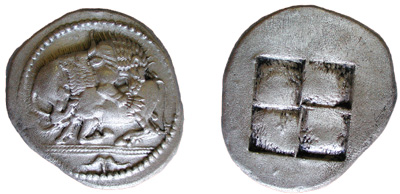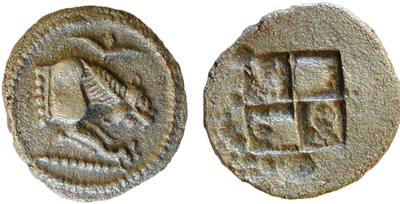Argilos minted its first coins during the last quarter of the 6th century B.C. The date is important since the minting implies that Argilos was a politically and economically independent city at that time. Until about the middle of the 5th century B.C., the Argilians minted silver tetra-drachms and smaller denominations, all bearing the abbreviation of the city’s name ARKILION as a legend. The coins show Pegasus on the obverse and on the reverse a Quadratum Incusum, not particularly clear on earlier coins but well cut on later ones.
In the excavations of the ancient city, coins of smaller denominations turned up, apparently destined for local use. The larger denominations, mainly tetradrachms, found their way to many areas around the Mediterranean, to Egypt, Asia Minor, and the Midlle East. Curiously, the city stopped minting coins for about one century and then resumed production, mostly of the common bronze denominations. These coins show a head of Apollon on the obverse , a deity probably worshiped in the city, and a bow on the reverse. Again, all the coins show the legend APKI.
The excavations in the city brought to light not only silver coins of Argilos, but also from cities like Litis and Akanthos. Coins of Alexander A’ and from various other « uncertain » macedonian origins were also found. However, the majority of the coins unearthed were made of bronze. Most come from Amphipolis, but Tragilos, Neapolis, the Bottiaion League, and the cities of the Chalkidiki peninsula are also represented. Others figure Macedonian kings (Aeropos, Amyntas III, Pausanias, Philip II, Alexander III, Demetrios Poliorketes, Antigonos Gonatas and Philip V). Coins from various cities of central Greece also found their way to Argilos.

Argilos (hemiobol, 470-460 av. J.-C.); Obv. : partie antérieure de Pegases à gauche. Bord avec points; Rev.: Quadratum Incusum Argilos (hémiobole, 470-460 av. J.-C.); Avers. : partie antérieure de Pegases à gauche. Bord avec points;
Revers.: Quadratum Incusum

Akanthos (tétradrachme, 500-478 av. J.-C.) Avers.: lion attaquant le flanc d’un bufle
Revers.: Quadratum Incusum

Akanthos (tétrabole, C. 478-465 av. J.-C.); Avers.: partie antérieure d’un lion à droite;
Revers.: Quadratum Incusum


